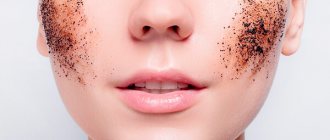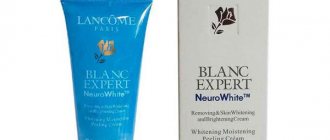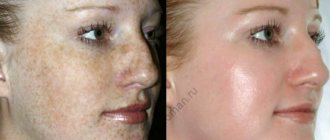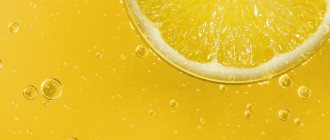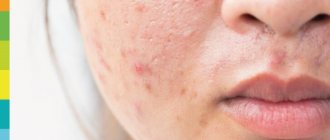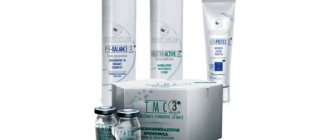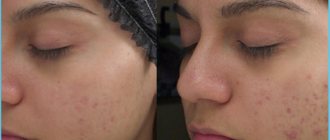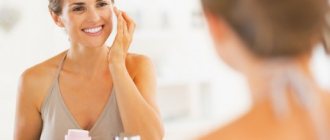Various acids in cosmetics are no longer news, but it still sounds a little scary, especially if you associate acid with chemistry lessons at school. There, during laboratory work, you could see how a whole piece of metal disappears in a small test tube. Don't be afraid, because acids in facial cosmetics are completely different. They are not just safe for our health, but even beneficial for the skin.
When we talk about acids in cosmetics, we mean exfoliation of dead skin cells. Deep peeling, in other words. The advantage of acids is not only this: in addition to the above, acids prevent moisture from evaporating from skin cells, i.e. help maintain skin elasticity and youth. The most famous of the “useful” acids is hyaluronic acid. She is a shining example of not so much exfoliation as nourishment and rejuvenation of facial skin.
Use of acids in cosmetics: why scrub the skin?
We don’t notice it, but our cells constantly live and die, several million per day. These very approximate figures may vary depending on weather and other environmental conditions, as well as diseases and genetic inheritance. If you don't touch the skin in any way, a lot of dead cells will accumulate. This leads to several unpleasant consequences:
- Early appearance of facial wrinkles or deepening of existing ones;
- Dullness and uneven complexion;
- Peeling of the skin, enlargement and clogging of pores.
These and other troubles can be easily eliminated by regular exfoliation of the skin in two ways:
- Mechanical peeling. The essence is to remove the topmost layer of skin, that is, dead cells. This is done with the help of abrasive particles; they can be found in some cosmetics: scrubs, peelings and others;
- Chemical peeling. It works a little differently - due to the presence of various acids in the composition. Like abrasive particles, acids remove the stratum corneum and improve the condition of the skin in general. This kind of cleansing allows nourishing cosmetics to work more effectively and penetrate deeper into the layers of the skin.
Modern dermatologists are increasingly turning to the second option, because it is less traumatic for the skin. In mechanical peeling products, exfoliating particles can be harsh and irritate the skin. Brushes and scrubs cannot give a long-lasting and strong effect, since they act on the very top layer of the skin without penetrating deep. The use of acids in cosmetics, on the contrary, allows the procedure to be considered therapeutic and can have a much more effective effect on the skin. This works by reducing the activity of the sebaceous sweat glands, as well as eliminating hyperpigmentation, post-acne and signs of photoaging, tightening pores, deeply nourishing and moisturizing the skin.
Kinds
AHA acids are as follows:
- Glycolic acid is effective in treating hyperpigmentation. Contained in green grapes and sugar cane.
- Citric acid – has a whitening effect, removes toxins, is responsible for cell renewal, and promotes collagen production. Contained in lemon, kiwi, lime, papaya, grapefruit, pineapple, orange.
- Lactic acid is responsible for moisturizing the skin and has an exfoliating effect. Contained in sour milk, grapes, yogurt, tomato juice, blueberries, apples, maple syrup.
- Tartaric acid – another name is tartaric acid. Exfoliates, moisturizes and whitens the skin. Included in ripe grapes, oranges, and wine.
- Malic acid – promotes cellular metabolism, exfoliates. It is found in large quantities in tomatoes and apples.
What problems can acids in cosmetics solve?
Acids of various types and stripes are similar in one thing - the principle of operation, namely in the dissolution of dead skin cells. This process frees up space for new cells to appear and reduces the number of dead cells in the future. In simple terms, you purposefully and carefully damage the skin to make the texture smoother and renew the cells. As a bonus, you will make it easier for moisturizing and nourishing products to work - after acid peeling, it will be much easier for the main components to penetrate into the deeper layers of the skin and work easier. In modern cosmetology, several categories of acids are used.
AHA acids in cosmetics
They are obtained from milk and various plants, but most of what we see in cosmetics is artificially created in laboratories. If the concentration of alpha acids is low, they can retain moisture inside skin cells (up to 4%). If more (from 5%), it works like a scrub - exfoliates dead cells.
AHA acids dissolve in water and cannot penetrate deep into the layers of the epidermis. But they work great on the surface itself:
- Exfoliate;
- Remove signs of aging: wrinkles, lack of firmness, radiance, elasticity, etc.;
- Remove hyperpigmentation;
- Fighting post-acne;
- They help collagen and elastin to be produced in the right quantities.
The most popular in this category is glycolic acid, it has been studied from all sides to find out its pros and cons. It is extracted from red cane and is considered the cheapest and most effective. It is also believed that extremely high concentrations of glycolic acid (found only in salon treatments) are very useful in treating advanced stages of acne. In addition, it helps increase collagen production and moisturizes the skin well.
Citric acid in cosmetics often acts not as an active component, but as a preservative or regulator of the acidity of the product. However, in terms of effectiveness and beneficial properties, it is very similar to glycolic. Mandelic acid is difficult to find in cosmetics, as it does not work as effectively and exfoliates less effectively. But mandelic acid is great for people with sensitive skin.
Home Recipes
Certain types of creams can be purchased at the pharmacy and you can prepare an effective skin care cream yourself at home. Popular homemade recipes are discussed in more detail below.
Orotic acid cream
To prepare the cream, mix 30 ml of almond oil and 10 ml of sucrose stearate, and then heat in a water bath for 10 minutes with the addition of 80 ml of basil decoction. Orotic acid (5 tablets) is crushed into powder and added to the prepared mixture. After the product thickens a little, add 5-6 drops of grapefruit essential oil.
Salicylic acid cream
The recipe for making a fairly simple wax in the amount of 10 grams is melted in a water bath and 10 ml of salicylic acid and rice oil are added. The finished cream is used after complete hardening.
Cream with ascorbic acid
To prepare, mix 50 ml of coconut oil with 100 ml of olive oil with the addition of 10 ml of lanolin and wax. The finished mixture is heated in the microwave for 40 seconds, and then 100 ml of non-carbonated mineral water and 50 ml of freshly squeezed aloe juice are added. 8 crushed tablets of ascorbic acid are mixed into the cream and seasoned with patchouli ether (a few drops).
Cream with hyaluronic acid
The cream is made by mixing the same amount (10 ml) of olive, linseed, sunflower oils and heated until warm in a water bath. Borax (10 ml) is dissolved in 50 ml of non-carbonated mineral water. The mixture is cooled and seasoned with esters (2 drops) of lavender or ylang-ylang. Hyaluronic acid (10 mg), previously diluted with a small amount of water, is added to the finished cream.
The use of BHA acids in cosmetics
This group of acids, unlike the previous one, is soluble in fat. This quality allows them to penetrate much deeper into the layers of the skin and cleanse the pores from the inside. They effectively fight acne, acne and act as a preventive measure. The most famous acid in this category is salicylic acid, although it differs in composition from others. As a mono product it has disinfecting and anti-inflammatory properties. Recommended for people with oily skin types prone to inflammation and acne. Like AHA acids, salicylic acid perfectly fights photoaging, hyperpigmentation and perfectly exfoliates the skin.
How to choose facial cosmetics with acids
Which product with acid in its composition you should choose depends on your goals and needs: get rid of acne, remove wrinkles, exfoliate the skin, and so on. If treatment and deep effects are not required, AHA acids are suitable. They will cope with photoaging, hyperpigmentation, dullness and exfoliation. Pay attention to the acid concentration in the cosmetic product. ANA acids should not be more than 10% (ideally 5-8%).
If your problems are acne, large clogged pores, etc., then BHA acids are suitable for you. For example, salicylic acid will help regulate the functioning of the sebaceous glands and relieve inflammation. Acid alone will not be able to cure acne, but it will greatly help special cosmetics penetrate deeper into the layers of the skin and work more efficiently. The optimal concentration of BHA acids in cosmetics is 1-2%.
Some cosmetics contain several acids from different groups. Multiple acids can work together and will not interfere with each other. However, the presence of more than one acid in the composition increases the risk of allergic reactions. One acid from any group is enough to exfoliate the skin and perform other tasks necessary for it. If the skin suffers from constant dehydration, then a combination of acids from different categories is quite possible: AHA can prevent moisture loss in skin cells, and BHA will disinfect.
Salon treatments
In aesthetic medicine centers, clients can be offered a wide range of services (primarily rejuvenation) related to acids.
p, blockquote 25,0,0,0,0 –>
Biorevitalization
Injection under the skin for the purpose of rejuvenation of hyaluronic acid in almost pure form. The skin becomes firm and youthful-elastic. Biorevitalization is an expensive, painful, but very effective salon procedure.
p, blockquote 26,0,0,0,0 –>
Mesotherapy
The technique and purpose of mesotherapy coincide with biorevitalization: the active substance is injected under the skin of the face and has a rejuvenating effect. However, instead of hyaluronic acid, meso-cocktails are used, in which various acids and vitamins can be mixed.
How to care for facial skin with acids
The following are not strict rules, but recommendations. They are worth knowing and considering before using mono-acids or cosmetics with acids. What you need to know:
- Acid needs to spend some time on the skin to work properly. What does this mean: “washes” will be useless, since they are on the surface of the epidermis for a very short time. Pay attention to tonics, serums, creams and other similar products. The latter will spend much more time on the skin and the acid will have time to work as it should;
- You should not apply all products with acids on yourself at once. This will only provoke an allergic reaction, or, at best, increase the sensitivity of the skin. If you have a gentle product, use it every day. It is better to apply a strong one to the skin once a week, or even two. Let's say you have a facial tonic with a mild acid in its composition - use it daily (preferably once a day). It is better to use an acid mask once a week, and the next day do not touch your face with anything. This way you will give your skin a little rest and recovery, and protect yourself from various types of allergies and irritations;
- If you are just getting acquainted with acids, start small: use cosmetics with acids once a week, then two, three, and so on. Don't forget the point above and remember that it all depends on your skin's needs. If you find that you only need a weak acid toner once a week, don't use it more often or add stress to your skin with anything else;
- If you have several acid products with different groups in the composition (for example, AHA and BHA), use these products on different days. You should not combine the use of all the remedies in one day, as you will do more harm than help;
- If you have sensitive skin areas, avoid them. Acids can only make the situation worse;
- Keep the product exactly as long as it is written in the instructions. You shouldn’t leave cosmetics on your face too long in hopes of the best - this is another way to increase sensitivity and lead to allergies;
- Test everything for allergies on the crook of your elbow before applying to your face. If you feel a slight tingling or see slight redness, this is normal. If the area where the acid was applied burns strongly, the skin is red and itchy, wash it off immediately. Don't be patient and wait for it to pass. There are three possible options: either the product is not suitable for you, or you applied too much, or left it on longer than expected. In any case, it's not worth the risk - this is no joke;
- In the sunny season, be very careful - acids increase the skin's sensitivity to ultraviolet radiation and can cause hyperpigmentation and scarring. Here's how it works: that same keratinized layer of cells acts as a kind of filter for the sun's rays, and acids remove it. There is no filter - there is nothing to protect the skin;
- To save yourself from troubles in the summer, always apply special sunscreen cosmetics before going outside. Cosmetics with SPF protect the skin from the harmful effects of the sun. It is best to protect yourself from the sun's rays all year round, even in winter. Even the weakest sun can damage the skin and cause photoaging.
Acids in cosmetics are necessary to help our skin be healthy, beautiful and radiant. Pay attention to your face: what exactly do you need? Based on your needs and requirements, you can choose suitable cosmetics. Use them correctly, following the recommendations, and there will be nothing to be afraid of.
Cosmo recommends
Queen of the Beach: 8 fashionable sundresses for a vacation on the coast
Vasilyeva Natalya Viktorovna, leading dermatologist-cosmetologist in the cosmetology department, doctor of the highest category at the Doctorplastic clinic: “Since ancient times, acids have been an integral part of beauty recipes that women use in the fight for youth and beauty of the skin. The plot from the now classic film “Moscow Doesn’t Believe in Tears” immediately comes to mind when one of the main characters appears on the screen with a strawberry mask on her face. A typical example of the positive effects of fruit acids on the skin. When acid is applied to the skin, we receive a chemical burn to a greater or lesser extent. Any damage to the skin helps to activate regenerative processes. The effect of the vast majority of peelings is based on this. The degree of damage depends on three main characteristics: the properties of the acid itself, its concentration in the solution and the acidity index (pH). Thus, the higher the concentration and the more the pH is shifted to the acidic side, the more aggressive the effect on the skin we get. The choice of acid or complex of acids depends on the goal and task that we set. There are no acids for young and mature skin, but there are problems that worry mainly young girls (acne), while others concern older women (wrinkles).


